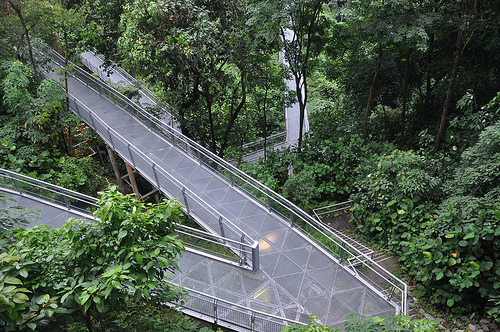January 30, 2012


With a population of over 4.4 million, Singapore is one of the most densely populated cities in the world. Juxtaposed to this crowded urban area is also over 2,000 plant varieties, 57 types of mammals, 98 types of reptiles, and 25 varieties of amphibians. Hundreds of bird and butterfly species migrate there each year and one third of the world’s hard coral reefs are found in its surrounding waters. The natural diversity that is Singapore includes rainforests, freshwater swamp forests, mangrove forests, and coastal forests. (Photo by )
[nggallery id=109 template=carousel images=4][imagebrowser id=109] By Debra Atlas
With a population of over 4.4 million, Singapore is one of the most densely populated cities in the world. Known at various times throughout its history as The Little Red Dot, the Lion City, and the City in the Garden, this tropical island city-state covers less than 300 square miles, over ten percent of which is land reclaimed from the sea.
Juxtaposed to this crowded urban area is also over 2,000 plant varieties, 57 types of mammals, 98 types of reptiles, and 25 varieties of amphibians. Hundreds of bird and butterfly species migrate there each year and one third of the world’s hard coral reefs are found in its surrounding waters. The natural diversity that is Singapore includes rainforests, freshwater swamp forests, mangrove forests, and coastal forests.
Green conservation here dates back to the founding of the Singapore Botanic Gardens in 1859. This small island-state originally was covered by primal rainforest. By 1880, only 7 percent remained. By 1895, however, over 88,000 acres had been designated as Forest Reserves in the Straits Settlements (a British colony which was comprised of Singapore, Penang, and Malacca, on the Strait of Malacca). The forest reserves reverted back to the Botanic Gardens’ Director of Gardens in 1939.
Since 1963, Singapore has been focused on recreating itself as a green destination. Planning decisions are based around designating almost two acres per every 1,000 people as nature reserves, planting nature strips or verges along both major and smaller roads, and landscaping parking structures and pedestrian overpasses with climbing plants, creepers, or screening shrubs.
Singapore signed onto the International Convention on Biological Diversity (CBD), the result of the groundbreaking 1992 Rio Earth Summit. That year, the government also launched the Singapore Green Plan, a 10-year national blueprint created to build a sustainable environment for future generations.
Currently, almost ten percent of the land is allocated to parks and legally protected nature reserves. These include the island of Pulau Ubin on the eastern side of Singapore, where visitors can run into wild boar roaming through the foliage, and Pasir Ris, a mangrove sanctuary.
According to National Parks Singapore (Nparks), the government agency tasked with conserving, creating, sustaining, and enhancing the country’s green infrastructure, 35 species of plants and animals new have been discovered and seven species thought to be extinct have been rediscovered on the island.
In 1991, The Garden City Action Committee began creating the The Park Connector Network. The plan encompassed green corridors that would connect parks, nature areas, and open spaces to populated areas covering the entire island. This linked matrix makes jogging, rollerblading, walking, and cycling to common destinations more accessible. Of the 300 kilometers (approximately 186 miles) to be completed by 2015, 100 km (approximately 62 miles) of paths are currently open.
There is a great deal more to tell in the story of Singapore’s greening. Future features will include The Gardens by the Bay and their natural wonders covering over 200 downtown acres, and the remarkable new terminal at Changi Airport with astonishing indoor tropical gardens and a live butterfly display.
It’s clear that, with the same human cooperation seen in Singapore, humanity and nature can coexist and thrive together.
Check out more articles by Debra Atlas
© 2012 SCGH, LLC.
]]>